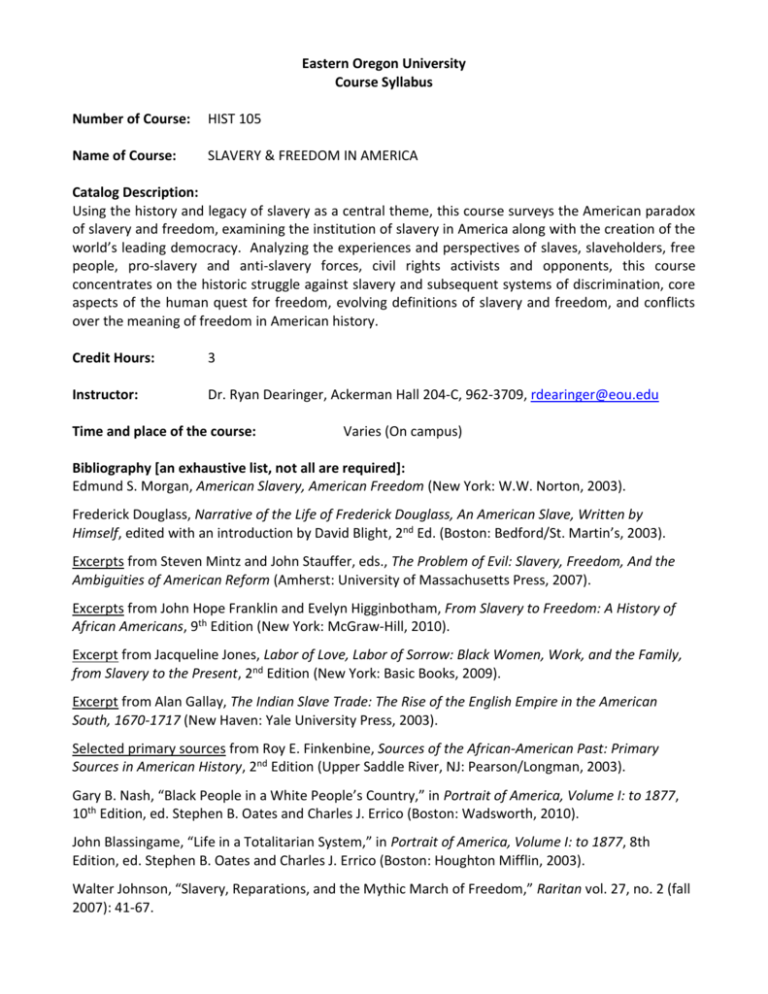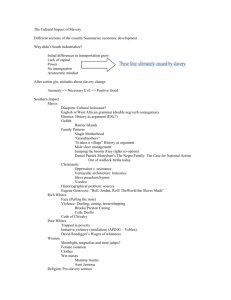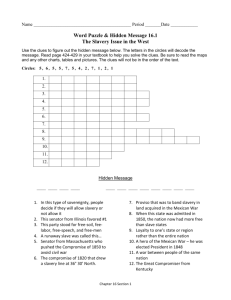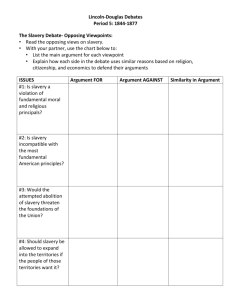
Eastern Oregon University
Course Syllabus
Number of Course:
HIST 105
Name of Course:
SLAVERY & FREEDOM IN AMERICA
Catalog Description:
Using the history and legacy of slavery as a central theme, this course surveys the American paradox
of slavery and freedom, examining the institution of slavery in America along with the creation of the
world’s leading democracy. Analyzing the experiences and perspectives of slaves, slaveholders, free
people, pro-slavery and anti-slavery forces, civil rights activists and opponents, this course
concentrates on the historic struggle against slavery and subsequent systems of discrimination, core
aspects of the human quest for freedom, evolving definitions of slavery and freedom, and conflicts
over the meaning of freedom in American history.
Credit Hours:
3
Instructor:
Dr. Ryan Dearinger, Ackerman Hall 204-C, 962-3709, rdearinger@eou.edu
Time and place of the course:
Varies (On campus)
Bibliography [an exhaustive list, not all are required]:
Edmund S. Morgan, American Slavery, American Freedom (New York: W.W. Norton, 2003).
Frederick Douglass, Narrative of the Life of Frederick Douglass, An American Slave, Written by
Himself, edited with an introduction by David Blight, 2nd Ed. (Boston: Bedford/St. Martin’s, 2003).
Excerpts from Steven Mintz and John Stauffer, eds., The Problem of Evil: Slavery, Freedom, And the
Ambiguities of American Reform (Amherst: University of Massachusetts Press, 2007).
Excerpts from John Hope Franklin and Evelyn Higginbotham, From Slavery to Freedom: A History of
African Americans, 9th Edition (New York: McGraw-Hill, 2010).
Excerpt from Jacqueline Jones, Labor of Love, Labor of Sorrow: Black Women, Work, and the Family,
from Slavery to the Present, 2nd Edition (New York: Basic Books, 2009).
Excerpt from Alan Gallay, The Indian Slave Trade: The Rise of the English Empire in the American
South, 1670-1717 (New Haven: Yale University Press, 2003).
Selected primary sources from Roy E. Finkenbine, Sources of the African-American Past: Primary
Sources in American History, 2nd Edition (Upper Saddle River, NJ: Pearson/Longman, 2003).
Gary B. Nash, “Black People in a White People’s Country,” in Portrait of America, Volume I: to 1877,
10th Edition, ed. Stephen B. Oates and Charles J. Errico (Boston: Wadsworth, 2010).
John Blassingame, “Life in a Totalitarian System,” in Portrait of America, Volume I: to 1877, 8th
Edition, ed. Stephen B. Oates and Charles J. Errico (Boston: Houghton Mifflin, 2003).
Walter Johnson, “Slavery, Reparations, and the Mythic March of Freedom,” Raritan vol. 27, no. 2 (fall
2007): 41-67.
2
Prerequisites:
none
Learning Outcomes (LOs, including DPD):
GEC LEARNING OUTCOME:
Content Knowledge (CK)
PROGRAM LEARNING OUTCOME: Communication (C); Critical Thinking (CT);
EOU DIVERSITY REQUIREMENT:
Difference, Power, and Discrimination (DPD)
Upon the completion of this course, students should be able to demonstrate:
1.)
Familiarity with the central social, cultural, political, and economic developments related to
the history of slavery and freedom in America (CK; DPD)
2.)
Competence in identifying, explaining, and contextualizing key historical concepts such as
freedom, diversity, democracy, slavery, racism, and discrimination (CK; CT; DPD)
3.)
An ability to locate, summarize, and critically analyze primary and secondary source evidence,
formulating independent questions and critiques (C; CT; DPD)
4.)
The capacity to recognize contexts and assumptions in historical evidence (CT; DPD)
5.)
An awareness of multiple perspectives both in history and in the interpretation of history (CK;
CT; DPD)
6.)
The skill of evaluating evidence to reach conclusions and presenting them clearly in writing
and orally (C; CT)
7.)
An ability to apply major analytical concepts—such as race, class, and gender—to the study of
slavery and freedom in America (CT; DPD)
8.)
An ability to work collaboratively with peers (C)
Course Requirements and Grading Policies:
General Participation:
5 points per week (50 total)
Five (5) primary source workshops:
10 points each (50 total)
Five (5) quizzes:
10 points each (50 total)
Four (4) analytical essays
25 points each (100 total)
Midterm exam:
100 points
Final exam:
100 points
Learning Outcomes:
1-2, 5-8
3-4, 5-8
2-6
2-7
1-7
1-7
Grades will be determined by the following percentage basis of the 450 possible points:
A
100-94%
A90-93%
B+
87-89%
B
84-86%
B80-83%
C+
77-79%
C
74-76%
C70-73%
D+
67-69%
D
64-66%
D60-63%
F
59% and “look out below!”
Means of Assessment and Connection to Learning Outcomes (LOs)
GENERAL PARTICIPATION (LOs 1-2, 5-8)
Includes attendance and active participation in class discussions and related activities. Lectures and
discussions are interactive and will explore evidence and pose questions related to subject matter
and course themes.
PRIMARY SOURCE WORKSHOPS (LOs 3-4, 5-8)
Small group workshops in which students identify, “unpack,” and analyze primary and secondary
source evidence. Students will frequently answer a series of significant questions, formulate their
own interpretations and critiques, and share their findings in the form of group presentations and
informal essays.
3
QUIZZES (LOs 2-6)
Creative exercises featuring short answer essay questions that ask students to evaluate scholarly
arguments/interpretations based on historical evidence.
ANALYTICAL ESSAYS (LOs 2-7)
Short (2 page) analytical essays that require students to craft a significant historical question,
examine the available [course] primary and secondary sources, and use critical thinking, logical
analysis, and clear writing to explore the question, formulating and supporting their answer or
conclusion.
EXAMS (LOs 1-7)
The midterm and final exams are, like the quizzes, creative exercises. They feature multiple choice
questions, short essay questions, and a long essay question that deal with core course concepts,
themes, evidence, and interpretations.
Brief Outline of Course/Weekly topics:
Week 1:
“Red, White, and Black”: Indians, Indentured Servants, and African Slaves
The African Slave Trade and Codifying Slavery in the Colonies
Week 2:
From African to African-American: Slave Communities
“Cry Liberty”: Slave Resistance and Rebellion
Week 3:
Slavery, Liberty, and the American Revolution
The American Dilemma: Slavery and Freedom in the U.S. Constitution
Week 4:
Slavery versus “Free” Labor
“Sold Down the River”: The Internal Slave Trade
The Defense of the Peculiar Institution: Slavery as a “Positive Good”
Week 5:
Antislavery
“A Fire-bell in the Night”: Slavery and the Crisis of the Union
Week 6:
The Civil War: “A New Birth of Freedom”?
Reconstruction: America’s Unfinished Revolution
Week 7:
“Worse than Slavery”: The Ordeal of Jim Crow Justice
“To ‘Joy My Freedom”: Black Women and Work in the New South
Week 8:
“At the Hands of Persons Unknown”: The Lynching of Black America
The Struggle for Civil Rights I: The Early 20th Century
Week 9:
The Struggle for Civil Rights II: The Movement at High Tide
From Nonviolent Resistance to “Black Power”
Week 10:
Modern Struggles for Freedom
Reparations and the Legacy of Slavery and Freedom in America
4
University Writing Requirement Outcomes:
n/a
Statement on Academic Misconduct:
Eastern Oregon University places a high value upon the integrity of its student scholars. Any
student found guilty of an act of academic misconduct (including, but not limited to, cheating,
plagiarism, or theft of an examination or supplies) may be subject to having his or her grade
reduced in the course in question, being placed on probation or suspended from the
University, or being expelled from the University—or a combination of these. Please see
Student Handbook at: Academic Honesty
Statement on Americans with Disabilities:
If you have a documented disability or suspect that you have a learning problem and need
accommodations, please contact the Disability Services Program in Loso Hall 234. Telephone:
962-3081.
Syllabus Prepared By:
Date:
03/02/12
Dr. Ryan Dearinger









